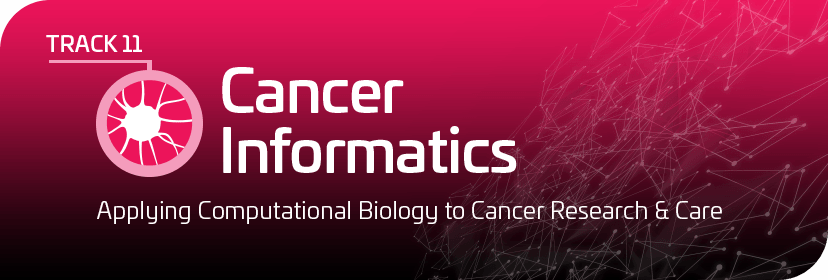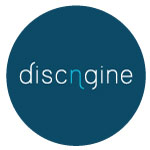
The Cancer Informatics track explores the important technology and informatics trends and challenges of applying computational biology and clinical data to cancer research and care. Themes that will be covered in expert-led presentations include collaboration
and network models, data access/management/integration strategies, visualization tools, and applications of biological interpretation to aid in research at the bench side or care at the bedside.
Final Agenda
Tuesday, April 16
7:00 am Workshop Registration Open and Morning Coffee
8:00 – 11:30 Recommended Morning Pre-Conference Workshops*
W6. DNA Sequencing 101
12:30 – 4:00 pm Recommended Afternoon Pre-Conference Workshops*
W12. Data Science Driving Better Informed Decisions
* Separate registration required.
2:00 – 6:30 Main Conference Registration Open
4:00 PLENARY KEYNOTE SESSION
Amphitheater
5:00 – 7:00 Welcome Reception in the Exhibit Hall with Poster Viewing
Wednesday, April 17
7:30 am Registration Open and Morning Coffee
8:00 PLENARY KEYNOTE SESSION
Amphitheater
9:45 Coffee Break in the Exhibit Hall with Poster Viewing
10:50 Chairperson’s Remarks
Robert Zeigler. PhD, Director, Customer Solutions, L7 Informatics, Inc.
11:00 Making Clinical Data Available to Researchers at the Princess Máxima Center for Pediatric Oncology with tranSMART and cBioPortal
Patrick Kemmeren, PhD, Principal Investigator, Princess Máxima Center for Pediatric Oncology
The Princess Máxima Center for Pediatric Oncology (https://www.prinsesmaximacentrum.nl/en)
is the centralized pediatric oncology center for all children with cancer in the Netherlands since 2018. As a new institute, the Princess Máxima Center has had the opportunity to set up their research IT infrastructure right from the start,
with limited legacy software to take into account. By building a Central Subject Registry (CSR), the center’s researchers have full access to pseudonymized data from all relevant hospital data sources in a timely manner. At regular intervals
the data from all hospital data sources are exported, transformed and pseudonymized, to be loaded in both the tranSMART and cBioPortal data warehouses, where the center's researchers can easily create their 'shopping list’ for patients and samples
of interest. The oncology center even extended the Glowing Bear user interface to notify researchers by email when new patients of interest are available, to ensure no time is lost waiting for research data and samples.
11:30 CO-PRESENTATION: Building a Standards-Based Clinical Data Resource for Cancer: Challenges, Goals, and Progress
Eva Lepisto, Data Services Team Lead, Dana-Farber Cancer Institute
Oncology’s pioneering role in precision medicine has led to routine tumor sequencing; Dana-Farber has clinically sequenced more than 30,000 tumors. However, the incompleteness and inconsistency of clinical data from EHRs and other sources present
significant challenges to building the patient-specific diagnosis, treatment and outcome data that are required to discover correlates to genomic data that inform diagnosis, prognosis, and personalized treatment. At DFCI, we are striving to improve
the quality and coverage of clinical data for translational research and clinical decision support. In this presentation, we will describe the standards-based data model we have created for representing cancer patient phenotypes, along with a
curation software platform we have developed to streamline abstraction of unstructured data into the standard data model and NLP approaches to populating the same model from clinical text.
 12:00 pm Discngine
presents 3decision, a Collaborative Platform for Structural Knowledge
Management
12:00 pm Discngine
presents 3decision, a Collaborative Platform for Structural Knowledge
Management
Eric Le Roux, CEO, Discngine
Peter Schmidtke, Scientific Project Manager, Discngine
Discngine develops innovative IT solutions for Life Science research. In 2018, It launched 3decision, a web application that combines a fully annotated & searchable protein structure database and a web-based user interface with state of-the-art
structural analytical tools. The user interface is designed to give molecular modelers, medicinal chemists and structural biologists a common ground for structure-based drug discovery.
12:15 CASE STUDY: How a Top Pharmaceutical Company Supports Scientific Discovery with Contextualized Information Retrieval
Michael Iarrobino, Senior Product Manager, Copyright Clearance Center
A pharmaceutical company needed a better way to support scientific discovery and realize the value of its information assets. But, with siloed data, a lack of awareness of available licensed resources, and multiple discovery workflows it was taking
researchers too long to find information and synthesize data to advance research. In this session, learn how the organization tackled these challenges.
12:30 Session Break
12:40 Luncheon Presentation I: Keys to Success in Preclinical Informatics Development; All About That Data
Graeme Dennis, Commercial Director, Pre-Clinical Pharma, IDBS
In the R&D industry today, beleaguered system implementations are more common than anyone would prefer to admit. Data harmonization tasks, expectation management, and risk mitigation opportunities can pass before their urgency is even
fully appreciated. This 30-minute talk will explore the keys to success for developing a data-centric approach to R&D, which acknowledges the breadth of project workstreams.

1:10 Luncheon Presentation II: Certara Integral: Next
Generation Data Repository
Kevin Trimm, Senior Director, Product Strategy & Services, Software, Certara
A successful drug development program relies on data being centralized in an accessible, understandable, mineable, traceable, and secure location for analysis and interpretation. Provisioning data to scientists in an organized manner with
high performance can be a challenge. Certara Integral is a validated and 21 CFR Part 11 compliant software as a service data and model repository utilizing the CDISC data model and Amazon Web Services Infrastructure, providing an intuitive
solution to this problem.
1:40 Session Break
1:50 PANEL DISCUSSION: Revolutionizing Drug Development with New Disease Models and Simulation Methods: Case Studies of Collaborative Global Efforts
Chairperson and Moderator:
Anil Srivastava, President, Open Health Systems Laboratory
Panelists:
Jeffrey Buchsbaum, MD, PhD, AM, Medical Officer and Program Director, Radiation Research Program, Division of Cancer Treatment and Diagnosis, National Cancer Institute/NIH
Rajendra Joshi, PhD, Associate Director and HOD Bioinformatics Group, Centre for Development of Advanced Computing (C-DAC), Pune University Campus
Tonglei Li, PhD, Allen Chao Chair and Professor of Department of Industrial and Physical Pharmacy, College of Pharmacy, Purdue University
3:25 Refreshment Break in the Exhibit Hall with Poster Viewing, Meet the Experts: Bio-IT World Editorial Team, and Book Signing with Joseph Kvedar, MD, Author, The Internet of Healthy Things℠ (Book will be available
for purchase onsite)
4:00 PANEL DISCUSSION: The Difference between Biomarkers and Diagnostics: It’s Bigger Than You Think
Moderator:
Michael N. Liebman, PhD, IPQ Analytics, LLC and Strategic Medicine, Inc.
Panelists:
Michael Montgomery, MD, Global Executive Director, Incyte Corporation
Jonathan Morris, MD, Vice President, Provider Solutions; Chief Medical Informatics Officer, Real World Insights, IQVIA
Jun Zhu, PhD, Professor, Genetics and Genomic Sciences, Icahn School of Medicine at Mount Sinai
Biomarkers are used to evaluate cancer risk, detect end stage cancer and suggest optimal therapy for specific patients. Recent advances in -omics research continue to enable researchers to classify molecular fingerprints of specific cancers.
Discovery and development of new cancer markers remains a major research focus to improve screening, diagnosis, and treatment but is hampered by the limited knowledge of the details of disease progression. This challenges the ability to
identify markers that may be causal rather than correlative and impacts their use as true diagnostics. By example, literature analysis of 250,000 papers listing biomarkers in cancer yield less than 100 FDA approved diagnostics. Every experiment
yields a biomarker; however, every experiment does not yield a diagnostic that can more accurately drive clinical action. How can we close this gap? It is critical to develop a better understanding of the disease process and how observations
from genomics, proteomics, and metabolomics may impact that process in different ways. This interactive panel will explore experimental and analytic methods, issues and challenges impacting identification, validation, development and implementation
in cancer, diagnosis and treatment.
5:30 Best of Show Awards Reception in the Exhibit Hall with Poster Viewing
Thursday, April 18
7:30 am Registration Open and Morning Coffee
8:00 PLENARY KEYNOTE SESSION & AWARDS PROGRAM
Amphitheater
9:45 Coffee Break in the Exhibit Hall and Poster Competition Winners Announced
10:30 Chairperson’s Remarks
Carlos Rios, PhD, Senior Research Investigator, Computational Genomics - Translational Medicine, Bristol-Myers Squibb
10:40 Longitudinal and Context Visualization for Precision Oncology
Jeremy Goecks, PhD, Assistant Professor of Biomedical Engineering and Computational Biology, Oregon Health and Science University
The goal of precision oncology is to find effective treatments for each patient’s cancer based its molecular profile. Visualization plays a key role in precision oncology, helping to understand and integrate longitudinal and complex
data analyses and then communicate results to physicians, patients, and other stakeholders. We will discuss our work applying visualization for precision oncology and identify opportunities and challenges for visualization in precision
oncology going forward.
11:10 Sharing and Visualizing Cancer Genomics Datasets Using cBioPortal
Carlos Rios, PhD, Senior Research Investigator, Computational Genomics - Translational Medicine, Bristol-Myers Squibb
BMS has been using cBioPortal for visualizing cancer genomics datasets since early 2016, supported by The Hyve, an open source bioinformatics company based in the Netherlands. The cBioPortal server runs on Amazon AWS and is tied to the company’s
Active Directory for authentication and uses Keycloak for authorization. Data can be loaded through a pipeline that takes input files from Amazon S3. For BMS, cBioPortal was extended with support for rich metadata and canvasXpress integration.
11:40 OncoThreads: Exploratory Visualization of Longitudinal Cancer Genomics Data
Theresa Anisja Harbig, MS, Research Associate, Visiting Graduate Student, Biomedical Informatics, Gehlenborg Lab, Harvard Medical School
New immuno-profiling assays and liquid biopsies have enabled researchers to study tumor development over time and to explore the effect of different therapies on cancer. To support exploration of such datasets, we developed OncoThreads,
a tool for the visualization of longitudinal cancer genomics data in patient cohorts (http://oncothreads.gehlenborglab.org/).
The tool is based on alignment of patient timelines into blocks, which can show data associated with patient samples or events such as drug administration. We demonstrate how the design of OncoThreads enables researchers to find
temporal patterns in longitudinal cancer genomics data, such as effects of treatments on mutation patterns
12:10 pm Enjoy Lunch on Your Own (Lunch Available for Purchase in the Exhibit Hall)
1:20 Dessert Refreshment Break in the Exhibit Hall with Poster Viewing
1:55 Chairperson’s Remarks
Yuval Itan, PhD, Assistant Professor, Department of Genetics and Genomic Sciences; Member, Charles Bronfman Institute for Personalized Medicine, Icahn School of Medicine at Mount Sinai
2:00 Pinpointing Transcript-Damaging Disease-Causing Variants as a Major Step towards RNA Therapeutics
Sahar Gelfman, PhD, Associate Research Scientist, Columbia University Medical Center
Since its publication in 2017, the Transcript-inferred Pathogenicity (TraP) model has become a major resource for genetic diagnostics, identifying pathogenic non-coding variants, and helping to change the common conception that pathogenic
genetic variation is caused solely by coding mutations. TraP has been incorporated in diagnostic pipelines in tens of research institutes worldwide. TraP is also available as a website for single queries (www.trap-score.org), providing
successful diagnosis of genetic disorders and affecting treatment decisions.
2:30 AI Assisted Rapid Clinical Whole Genome Sequencing for Critical Care
Ray Veeraraghavan, PhD, Director of IT & Informatics, Rady Children's Institute for Genomic Medicine
3:00 Deciphering the Complex Heterogeneity of Cancer
Patrice M. Milos, PhD, Co-Founder/President and CEO, Medley Genomics, Inc.
Medley Genomics provides a software platform that uses patent-pending algorithms and advanced data analytics to describe a patient’s diverse tumor cell mixture. This enables creation of unique molecular diagnostic fingerprints for
improving patient diagnosis, monitoring and treatment of cancer, and helps to improve novel oncology therapies and therapeutic combinations including individual cancer vaccine development.
3:30 Estimating Genotypic Heterogeneity Underlying Human Disease
Yuval Itan, PhD, Assistant Professor, Department of Genetics and Genomic Sciences; Member, Charles Bronfman Institute for Personalized Medicine, Icahn School of Medicine at Mount Sinai
Whole exome and whole genome sequencing provide hundreds of thousands of genetic variants per patient, of them only very few are pathogenic. Current computational methods are inefficient in differentiating pathogenic mutations from neutral
genetic variants that are predicted to be damaging and cannot predict the functional outcome of mutations. We will present deep learning approaches and machine learning methods in the role of detecting pathogenic mutations. Visualization
tools for better utilizing NGS data will be presented to understand human disease genomics.
4:00 Conference Adjourns